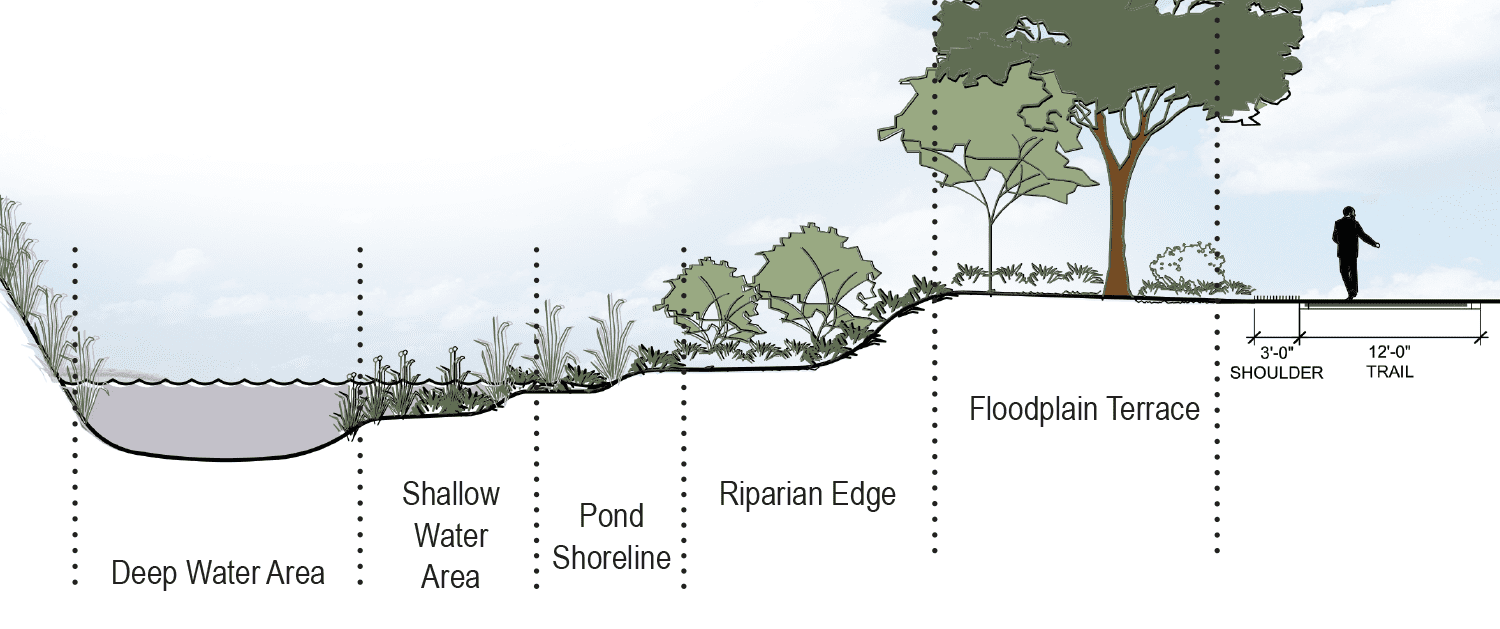Streambanks are challenging sites to establish plant material. Fluctuating water levels and moving water (not stagnant) make for much of the variability in the success of these planting approaches.
Due to this variability, areas in close contact with stream channel should be planted with a focus on stream stabilization, rather than for aesthetic reasons.
NOTE: Streambank planting should utilize strictly native plants, and plants have a tendency to migrate in these locations.
- Common invasive species in wetland and mesic streambank areas include reed canary grass, common reed, purple loosestrife, and cattails. If the invasives species cover is greater than 30% of the wetland or streambank area, this condition should be remedied through removal of invasives and replanting of native species, especially during the establishment period. If possible, invasives should be eradicated during the first month of discovery.
- If design species continue to fail to become dominant, soil pH, soil permeability, hydrology, or salt content may be incorrect for the selected species. Recommend consulting designer for plant material adjustment and implement soil testing.
- No more than 10% of the wetland or streambank area should be bare ground, and should not observe loss of more than 20% of a single plant species by number of plants.
Lower Slopes
- Shallow water areas, pond shoreline, and lower slopes of the riparian edge should be planted as needed for stabilization purposes.
- Plants should be able to tolerate poor water quality for a short period of time and filter pollutants.
- Bank stabilization may be required, especially on bank-cut sides. Consider using live stakes for planting.
- Planting in this area can be hydroseeded in low-water seasons. Plugs and live-stakes are preferred, particularly in areas where higher water velocities can be expected.
- In general, due to high failure rates in these areas, smaller plant material should be utilized to minimize costs.
Upper Slopes
- Upper slopes of the riparian edge and higher can be planted for more aesthetic purposes.
- Larger plant material can be used in these areas.
- Seeding can be performed with greater likelihood of success in these areas.
Streambank Plant List
TREES
- BALD CYPRESS Taxodium distichum
- BLACK TUPELO Nyssa sylvatica
- SYCAMORE Platanus occidentalis
- TULIPTREE Liriodendron tulipifera
- SWAMP WHITE OAK Quercus bicolor
- RIVER BIRCH Betula nigra
- SUGAR HACKBERRY Celtis laevigata
- SWEETBAY MAGNOLIA Magnolia vigriniana
SHRUBS
- WINTERBERRY Ilex verticillata (‘Red Sprite,’ ‘Winter Red’)
- VIRGINIA SWEETSPIRE Itea virginica
- REDTWIG DOGWOOD Cornus sericea
HERBACEOUS PERENNIALS
- SWITCHGRASS Panicum virgatum
- GRAY’S SEDGE Carex grayi
- LITTLE BLUESTEM Schizachyrium scoparium
- COMMON OAT Avena sativa
- NORTHERN SEA OATS Chasmanthium latifolium
- FOX SEDGE Carex vulpinoidea
- RUSH Juncus effusus
- SNEEZEWEED Helenium autumnale
- COMMON MILKWEED Asclepias tuberosa
- TALL COREOPSIS Coreopsis tripteris
- PRAIRIE DOCK Silphium terebithinaceum
- COMMON MOUNTAIN MINT Pycnanthemum virginianum
- WILD BLUE INDIGO Baptisia australis
- OBEDIENT PLANT Physostegia virginiana
- WILD GOLDEN GLOW Rudbeckia laciniata
- GOLDEN ALEXANDERS Zizia aurea
- COMPASS PLANT Silphium laciniatum
- SAWTOOTH SUNFLOWER Helianthus grosseserratus
- PARTRIDGE PEA Chamaecrista fasciculata
- SWAMP MILKWEED Asclepias incarnata
- JOE-PYE WEED Eupatorium maculatum

